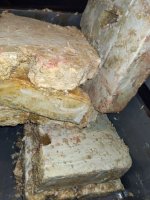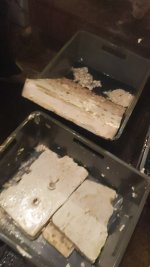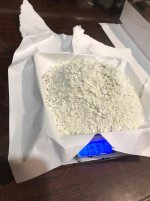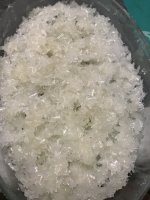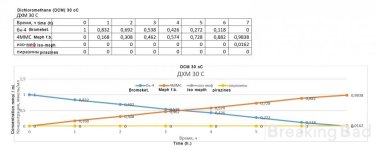4-MMC (mephedrone) synthesis. Bromination in dichlormethane.
Chemix-Express
🥷 RESIDENT 🥷
I am very interested in your comment. Someone has already mentioned this here on the forum.
I plan to set the temperature rigidly at 34 degrees (half of the given range of 32-36 degrees) and the reaction time at 4h.
The person who gave this information also gave proportions for this reaction.
Namely:
- 100g bk4
- 250ml DCM
- 150ml m40
1. will these proportions of reagents be correct?
2. i am to add 1/2 m40 at the beginning and 1/2 m40 after one hour of reaction. What is the purpose of this? I understand to tame the temperature, but what difference does it make if we do it in 1 go or spread it over two approaches?
I have already had one approach to this attempt. I added everything in the proportions as above. I heated the mixture to 20 degrees and started adding the m40. Unfortunately the temperature did not start to rise on its own. After starting the heating from outside, the temperature suddenly jumped to 40 degrees. The liquid was boiling and turning off the heating did not help.
What I think. Heat the reaction mass to 25-30 degrees before adding the m40 and only start gradually adding the m40 so as not to exceed the mentioned 36 degrees? Is this OK? Or do I heat the whole thing up to the reaction temperature of 34 degrees and only then add the m40?
I have one more question. How do I clean the free base?
Washing the free base twice with an equal volume of 10% sodium trisulphate solution to remove any remaining bromoketone and washing it 2 times with clean water is sufficient? Is it necessary to use something else?
Why is it that when I neutralise with hydrochloric acid in acetone to pH 6, when adding the HCL:acetone mixture to the free base it starts to turn colourful. It's terribly difficult to wash the powder to snow white afterwards.
The colours that have occurred to me are blue, green, dark red and pink.
I plan to set the temperature rigidly at 34 degrees (half of the given range of 32-36 degrees) and the reaction time at 4h.
The person who gave this information also gave proportions for this reaction.
Namely:
- 100g bk4
- 250ml DCM
- 150ml m40
1. will these proportions of reagents be correct?
2. i am to add 1/2 m40 at the beginning and 1/2 m40 after one hour of reaction. What is the purpose of this? I understand to tame the temperature, but what difference does it make if we do it in 1 go or spread it over two approaches?
I have already had one approach to this attempt. I added everything in the proportions as above. I heated the mixture to 20 degrees and started adding the m40. Unfortunately the temperature did not start to rise on its own. After starting the heating from outside, the temperature suddenly jumped to 40 degrees. The liquid was boiling and turning off the heating did not help.
What I think. Heat the reaction mass to 25-30 degrees before adding the m40 and only start gradually adding the m40 so as not to exceed the mentioned 36 degrees? Is this OK? Or do I heat the whole thing up to the reaction temperature of 34 degrees and only then add the m40?
I have one more question. How do I clean the free base?
Washing the free base twice with an equal volume of 10% sodium trisulphate solution to remove any remaining bromoketone and washing it 2 times with clean water is sufficient? Is it necessary to use something else?
Why is it that when I neutralise with hydrochloric acid in acetone to pH 6, when adding the HCL:acetone mixture to the free base it starts to turn colourful. It's terribly difficult to wash the powder to snow white afterwards.
The colours that have occurred to me are blue, green, dark red and pink.
subzero013
🥷 RESIDENT 🥷
You will need to cool, and not heat if you want to do at a temperature of 34 degrees. After adding methylin in 10 - 15 minutes, the mixture will begin to self -heal, heated bromketon before adding methyline. It is not particularly clear why exactly 34 degrees, dichlormethane boil with dissolved bromketon will be at high temperatures. When acidic, acetone often gives the color to Mephedron, someone recommends that it use ethylacetate instead and acidify with salt -acid isopropanol, someone to sour with water and then remove it.
Chemix-Express
🥷 RESIDENT 🥷
Hi. After reconstitution of BK4 in DCM (25-26 degrees C), the flask was placed on the agitator and the maximum stirring was turned on. Heating is disabled. The entire m40 was added at once, after 5-10 min the temperature began to rise to 35-37 degrees in 30-35 minutes, after which it began to fall down on its own. You mentioned that the whole reaction should last about 3.5-4 hours and will end when the temperature automatically begins to drop. For me, it warmed up to only 35-37 degrees in 30-35 and began to fall down. What am I doing wrong?
WhalterWhite
🥷 RESIDENT 🥷
WhalterWhite
🥷 RESIDENT 🥷
Benzene will work fine, but the methodology will change a bit. PM me and I'll tell you everything in detail.
Chemix-Express
🥷 RESIDENT 🥷
Can I also ask for some tips on the reaction to benzene? Currently, on benzene, the yield on crystal is around 53-55%. Maybe something will be useful. Regards and alletings
Dont use
Bezen is toxik use toulen or dcm
Bezen is toxik use toulen or dcm
breathing.fire
🥷 RESIDENT 🥷
Anybody try do this with methylamine 33% in methanol?
Police chemist say 24h in 20°c with toulen is much synthesis best is fast pure and much.
breathing.fire
🥷 RESIDENT 🥷
If I don't have acetone or IPA I can replacement them with other alcohol like methanol or ethanol?
The alcohols have to be of good quality to fit. IPA is the most readily available. Methyl and ethyl should also work, but they are harder to find the right quality.
About Us
Our team brings together the best specialists from different fields.
We are ready to share our experience, discuss difficult issues and find new solutions.

